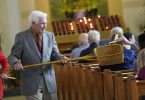by Joe Bollig
joe.bollig@theleaven.org
KANSAS CITY, Kan. — Happy New Year!
No, we’re not early. A brand-new liturgical year for all Catholics begins on Nov. 30, the First Sunday of Advent.
You may not have thought a lot about Advent when you were a kid. After all, Christmas (day or eve) was when you finally got to tear into those alluring packages under the tree.
And the carols! And the food! And the lights! And the TV shows!
Christmas gets all the glitter and silver bells.
But Advent? What’s so great about Advent? Quite a bit, upon second look. Sometimes it takes a bit of time and maturity to truly appreciate the greatness of Advent.
Advent is about anticipation and preparation. It’s about looking forward to something fantastic. It’s our spiritual journey to Christmas and beyond — the coming year, as well as eternity.
“Advent is the beginning of our liturgical year,” said Father Francis Hund, pastor of Good Shepherd Parish in Shawnee. “We look at the mystery of the Incarnation — of God coming to dwell among us, as told in the Gospels of Luke and Matthew.
“We begin with the mystery of Jesus coming to dwell among us,” he continued. “[This] leads us to Jesus’ ministry and mission, and then to the paschal mission, which culminates in the resurrection. [Advent] is a continual renewal of faith for us.”
Wonderful things take place during the four weeks of Advent — many of them rooted in the most ancient traditions of the church.
Some saints’ feast days during this time have become associated with the journey to Christmas, like jolly old St. Nicholas’ on Dec. 6, and St. Lucy’s on Dec. 13. Two Marian solemnities are also celebrated during this time: the Immaculate Conception on Dec. 8, and Our Lady of Guadalupe on Dec. 12.
Father Hund’s family celebrated St. Nicholas Day when he was growing up on the farm.
“It would be after supper,” he said. “We’d be doing our homework or the dishes, and we’d hear a knock on the front door. When we opened it, no one was there, but someone left some candy.”
Some Hispanic families observe Las Posadas (“The Inns”), a nine-day celebration lasting from Dec. 16 to Christmas Eve. Las Posadas reenacts the search for lodgings by Joseph and Mary after arriving in Bethlehem. It involves a procession with prayers and singing, culminating in a party.
Many other Catholics — and now even some Protestants — work their way through the season with the help of an Advent calendar. This tradition features little cardboard “doors” that are opened each day, revealing special prayers and activities that families can use to count down the days before Christmas.
Other families (and some churches) put up a Jesse tree instead, which is inspired by the Book of Isaiah (11:1- 3), and highlights the ancestry of the Messiah. A Jesse tree’s branches are hung with symbols from Old Testament figures, such as an apple for Adam and Eve, a rainbow for Noah, and a harp for King David.
But perhaps the most familiar seasonal devotion found in homes and churches is the Advent wreath. Usually a circle of greens, but sometimes of ceramic or metal, the Advent wreath has four candles — three violet and one rose. Starting with the lighting of a single violet candle, family members gather around the wreath each night for a short prayer service. (On the second Sunday of Advent, a second violet candle is lit as well. On the third Sunday of Advent, the rose candle is lit, followed by the remaining violet candle on the final Sunday of the season.)
Sometimes a white candle, which symbolizes Christ, is put in the center and is lit on Christmas Eve.
Since Advent is a time of preparation, it’s also a great time to seek the sacrament of reconciliation, said Michael Podrebarac, archdiocesan consultant for liturgy.
“It’s not a penitential season, but as a time of preparation it has a penitential character to it,” he said. “It doesn’t have the same intensity of Lent. But if Christ is coming in the liturgical feast of his glory, our modesty, our anticipation, and our solemnity help prepare us for those realities.”
Do you want to have a good Advent? Then concentrate on the readings for Mass, said Podrebarac. Read them at the dinner table and discuss them. Pray with your family around the Advent wreath.
“Also, take advantage of the cultural activities,” he said. “Go sing Christmas carols. Take part as a family in the merriment, whether shopping, or planning, or baking.”
“The things we do culturally at Christmas are not the enemies of our religion,” he continued. “We can go overboard, however. If you’re tired of Christmas when it comes, you haven’t lived a good Advent.
“But if the things we do over the course of the four weeks make us even more excited about Christmas, then I think we’ve done a good thing with our Advent.”






